Slicing is a common woe among golfers that can wreak havoc on their game. And there’s no denying that several golfers, whether rookie or advanced players, struggle to get their slices right.
Fret not! We’ve got you covered.
In this guide, we’ll delve deep into understanding what a slice is in golf, its repercussions, why people can’t get their slices right, and, most importantly, how to fix a slice.
Key Takeaways
- You must ensure a strong grip to help close the clubface during your swing.
- You have to keep your clubface square during your swing and visualize the club toe turning and closing to prevent an open clubface.
- Try to hit the golf ball in the middle or slightly toward the outer edge of the clubface to prevent slicing.
What Is A Slice In Golf?
Before we fix a slice, it’s essential to understand what a slice in golf is and the reason behind it.
Put, a slice is a one-of-a-kind shot that curves from the left to the right (for a right-handed golfer) and vice versa.
This unwanted curve often lands the ball right up in the coconut trees, leading to missed fairways and adding to your frustration.
Types Of Slices
For the sake of brevity, we will consider things from a right-handed golfer’s perspective.
There are two types of slices: the classic and the push. The former is a scenario where the ball starts to swing to the left of the target, takes on an excessive curve to the right, and unexpectedly lands more suitable to the target.
In comparison, the latter, i.e., the push slice, begins its curve from the right of the target line and moves even further right. Yes! I agree. A total disaster!!
Why Does A Slice Happen Anyway?
You can’t predict a slice in golf from the very beginning.
There is a combination of factors at play, such as grip, clubface alignment, swing path, posture, contact point, the angle of the clubface at impact, and the spin applied to the ball.
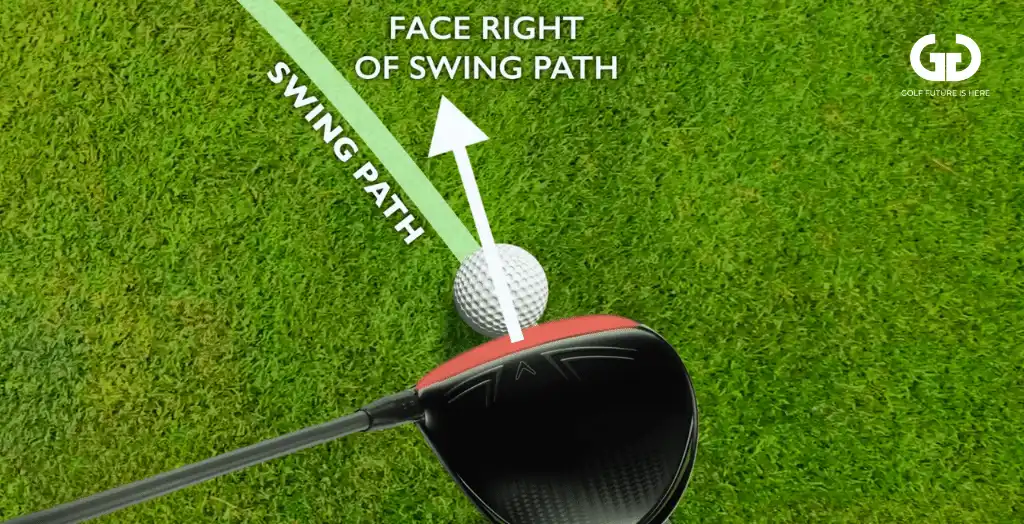
Typically, a slice happens when the clubface is kept open, pointing to the right of the target for a right-handed golfer at an impact relative to the swing path.
Such a scenario invariably leads to adding a sidespin on the ball. It curves away from the target for no good.
Why Slice Is A Terrible Thing For A Golfer?
A slice shot in golf is never good for more than one reason.
- A shot beyond your control: As you know by now, a slice is unwanted. However, things can go terrible when it’s windy, and your shot can look crazier, with some going high and some going low. In short, it puts you in the weak spot.
- It makes aiming difficult: It’s only frustrating when you can’t seek left. And the ball goes to the right no matter how hard you try. Try and keep things to more left. Yeah, it will not work, but hang on there.
- You end up losing a good amount of distance: As an average golfer, that’s something you cannot afford at all costs. When you give up distance, it invariably makes the game more challenging.
How To Fix A Slice In Golf?
Before you try to fix your slice, you must understand that the golf ball will turn the way the clubface is pointed as it’s open to the path of impact when a golfer slices. Here’s how to go about fixing your slice:
1. Strengthen Your Grip
When hitting a ball in golf, pointing the clubface in the right direction is of utmost importance to slice it. However, it’s not that easy, and one core factor that aids in the purpose is strengthening your grip.
Strengthening implies adjusting your grip on the club aptly. To do so, rotate your left hand slightly towards the right. (It’s for right-handed golfers; left-handed can do vice-versa).
Thus, looking down, you will see more knuckles on your left hand.
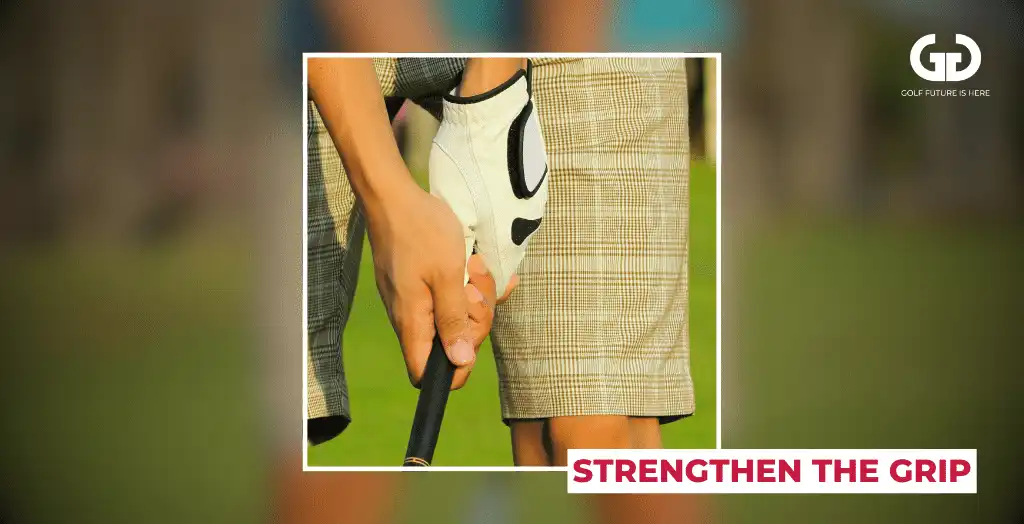
Consequently, move your right hand so that you place it beneath the club. While doing so, it’s crucial to ensure that your hands are held stronger to the grip, not too rigid or loose.
Moreover, with this grip style, you can seamlessly close the clubface when you swing.
Furthermore, throughout your swing, ensure your clubface is pointing down so that your left wrist remains bowed when you lean towards the top of the backswing.
2. Control Your Clubface
One of the major mistakes that most golfers make is not ensuring a square clubface during a swing.
Therefore, before you swing, keep an eye on your clubface, which isn’t titled towards the side. If it does, position the clubface straight.
Further, you must feel that the club toe rotates and closes towards impact. To implement the same, visualize your club toe turning and closing when you swing.
After a swing, roll over your right forearm over the left with further swings, and do not turn them straight away.
The above ensures that your clubface isn’t open during swings and thus prevents slices.
3. Change Your Path Into The Golf Ball
To avoid slicing in golf, changing your swing style is of utmost importance. Another common reason for slicing is that your club goes from outside to inside instead of vice-versa.
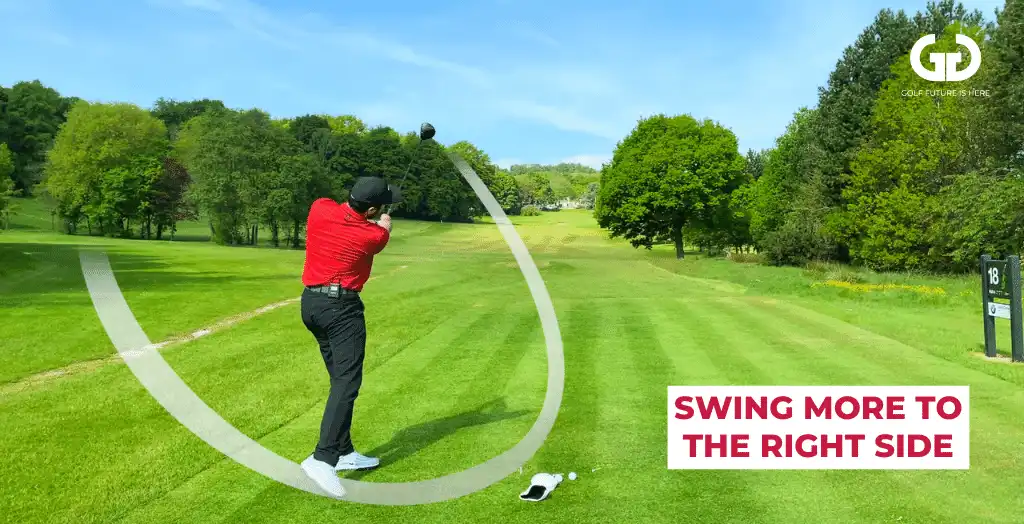
To resolve it, use an obstacle in the path to avoid slices. You can keep your headgear to the right of your golf ball, which is outside the swing path.
Next, swing inside the region of the headgear, and then you can swing inside the swing path. You can also use equipment like but, cap, bottle, or similar, but ensure not to hit those equipment.
4. Fix Your Posture
Proper golf posture is essential for a successful game, yet many golfers need help with incorrect positioning, which leads to suboptimal swings.
A common issue is the failure to hinge properly from the hips and an overreliance on knee flex. This crowds the ball and results in a steep out-to-in swing path.
Fortunately, you can transform your technique and address these problems with a few straightforward adjustments. Here’s a concise guide to help you rectify your golf swing posture:
1. For Alignment And Hip Positioning
- Stand upright, holding your golf club with both hands.
- Press the club against the top of your hips.
- Begin bending forward at the hips, ensuring you initiate the movement from this pivotal point.
2. For Grip And Knee Flex
- Maintain a regular grip on the club, as you would before taking a shot.
- As you feel a slight tension in your hamstrings, bend your knees slightly.
- Ensure the club rests lightly on the ground.
3. Weight Distribution
- Keep your weight balanced between your heels and the middle of your feet.
4. Elbow Alignment
- Throughout your swing, pay close attention to the distance between your elbows.
- Prevent them from separating excessively, as this can affect your swing’s consistency.
5. Initiating The Swing
- Refrain from lunging into the ball with your upper body and arms during the downswing.
- Instead, start your swing from the ground up, allowing for a smoother and more controlled motion.
Following these steps, you can correct your golf swing posture and address the issues associated with improper hip hinge and excessive knee flex.
This will help you avoid the pitfalls of crowding the ball and steep swing paths and contribute to more accurate and powerful shots.
5. Improve Your Contact
One of the most effective ways to reduce slicing is to contact the center or slightly toward the outer edge of the club face. By implementing it, you make a good strike by hitting accurate shots.
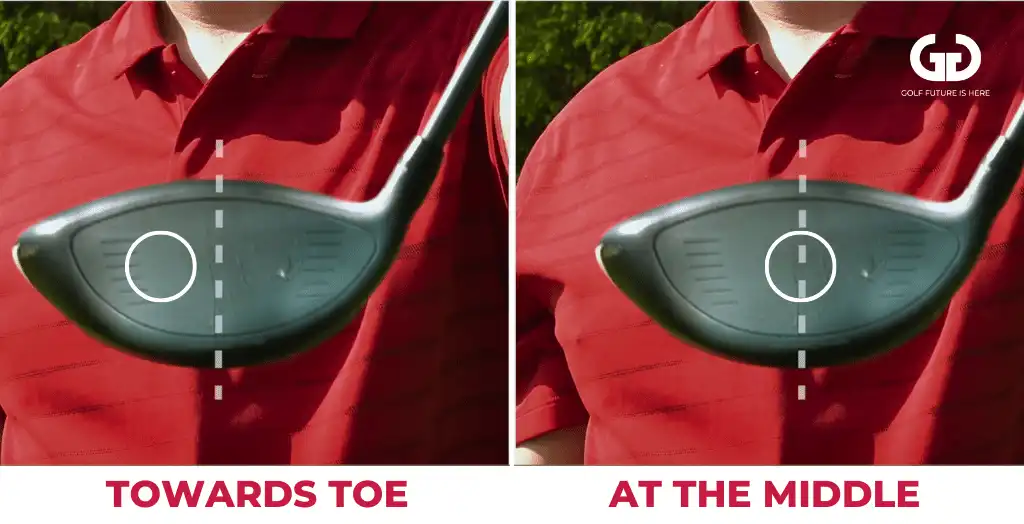
One such instance is hitting the ball closer to the outer edge. Consequently, the club spins so the golf ball goes appropriately from right to left, making an accurate draw shot.
Check Out: Draw vs Fade Explained: The Most Heated Golf Swing Debate
Why Do I Slice With My Driver But Not My Irons?
It all boils down to understanding the rift between sidespin and backspin. It’s simple. You slice more with your driver because of less backspin and more sidespin. However, it depends on whether your clubface is more closed or open at impact.
When creating more backspin, you must work with lofted clubs as they negate sidespin. Compared to that, drivers have the least amount of loft, and thus it mitigates less sidespin.
The other thing that comes into play is the length of the club. For the majority of golfers, longer clubs are way harder to make an impact with.
Once you know how to stop slicing the driver, you can automatically get even with your irons.
Wrapping It Up
Honestly, solving the golf slice is like putting together pieces of a puzzle. So, don’t expect miracles overnight.
Start by visualizing the adjustments and practice well. Especially during rounds, don’t lose your focus from your shots. To address the driver slices, try variations with swings and ball positioning.
FAQs
What is the correct grip to fix a slice?
There is no right or wrong grip. It all boils down to adjustment according to the scenario. So, while looking to fix a slice, try to adjust your grip to a neutral or slightly strong position.
As a new golfer, how do you stop slicing the driver?
To stop slicing your driver, you must rectify your driver setup, ball position, and swing speed. Also, aim slightly right to counteract the slice.


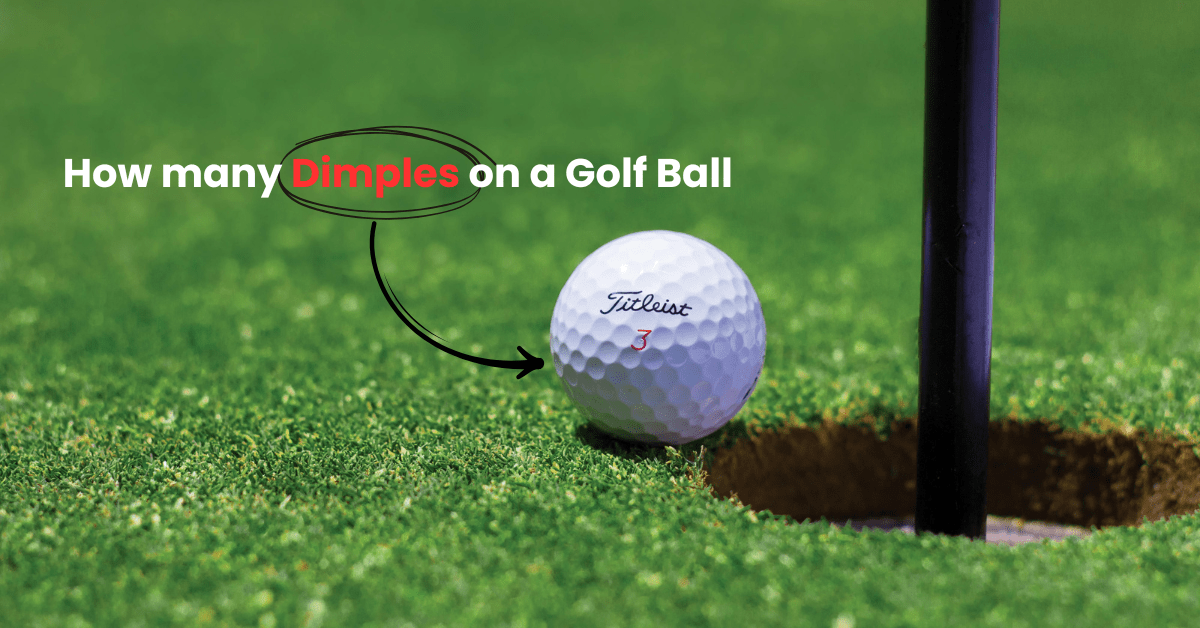
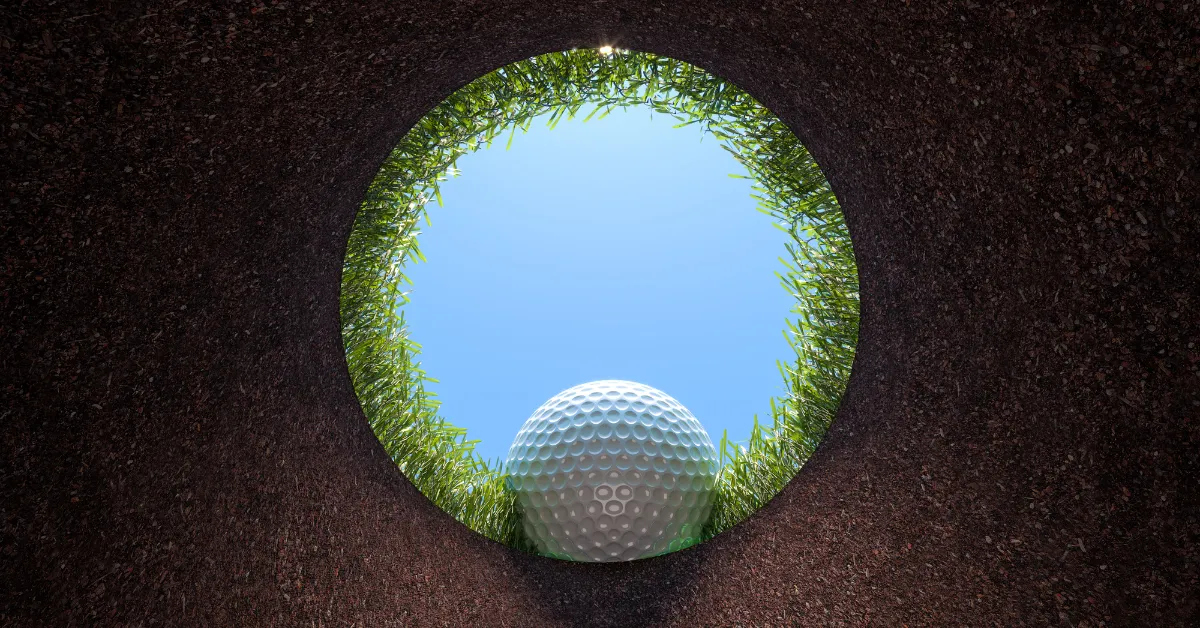
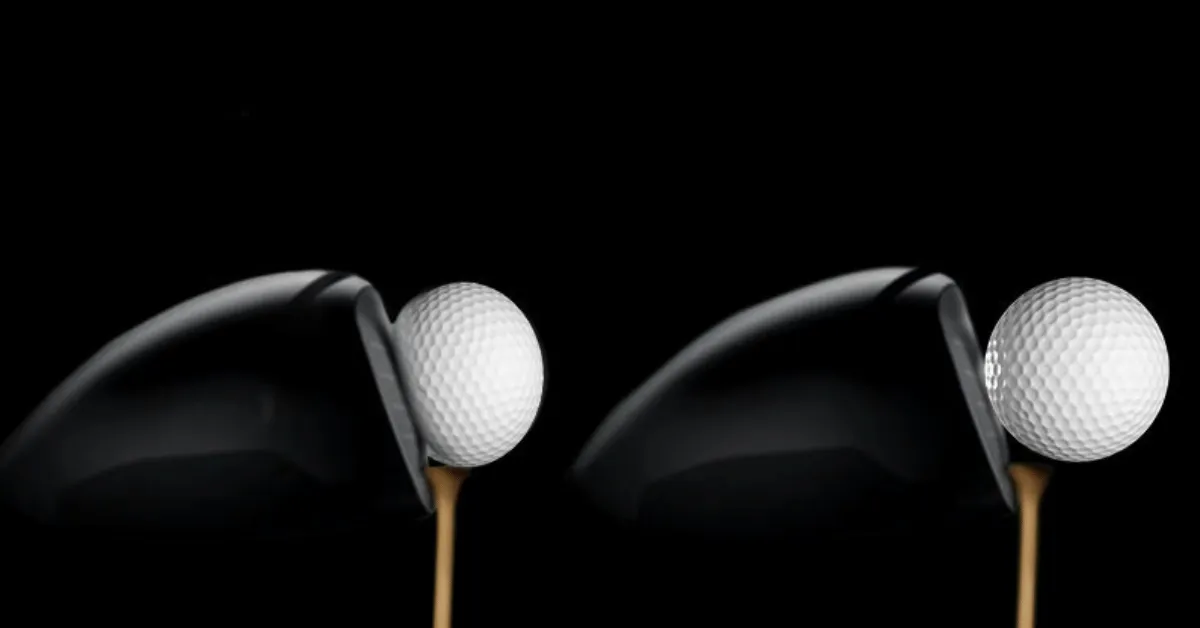
0 Comments